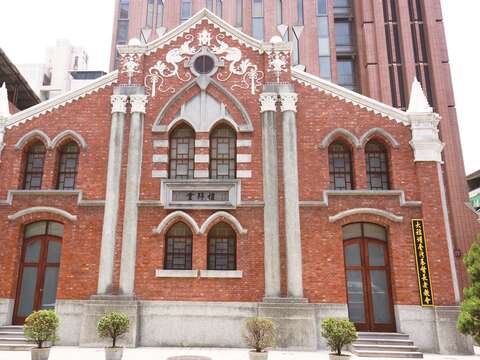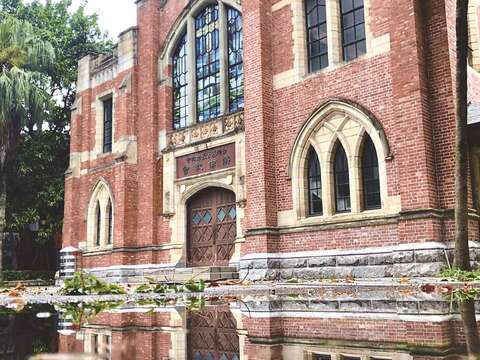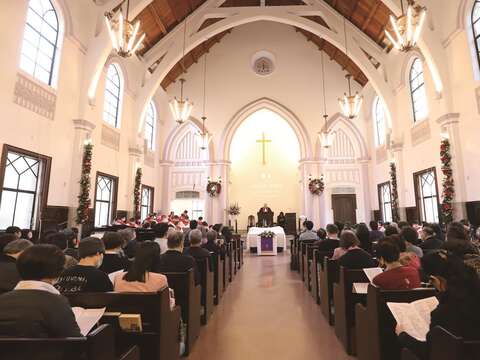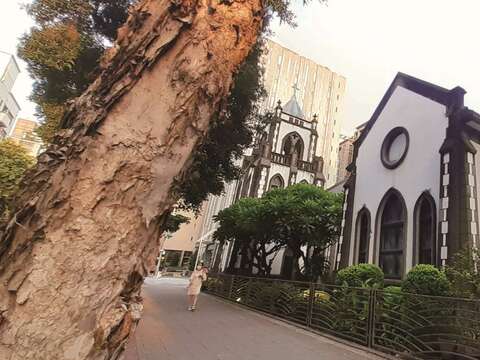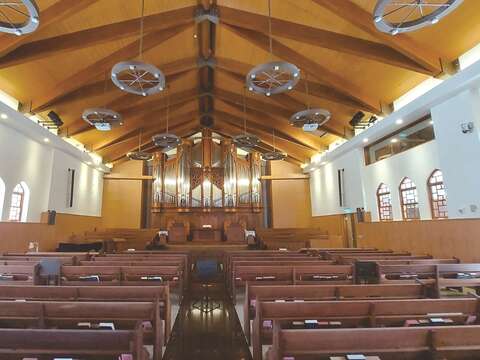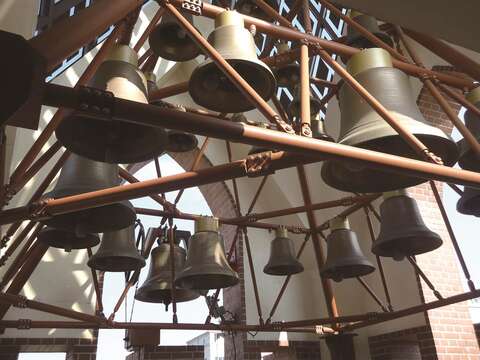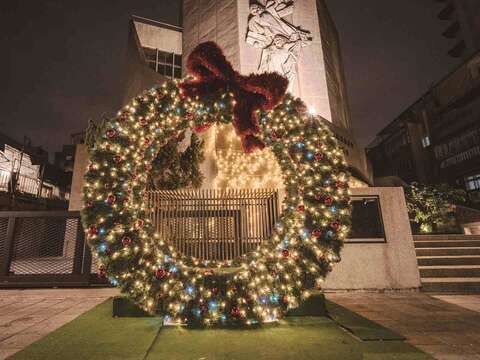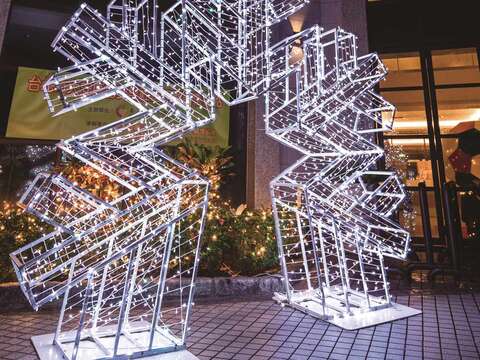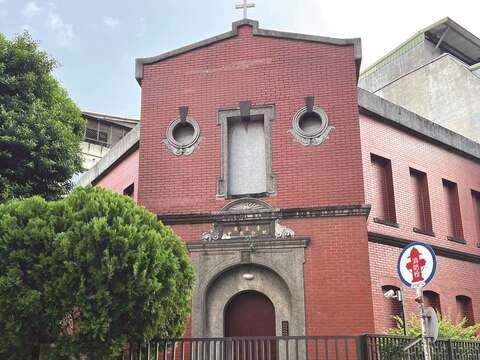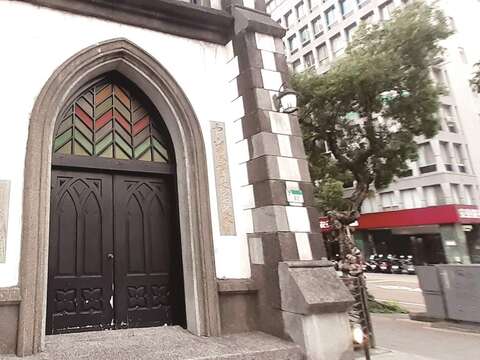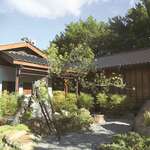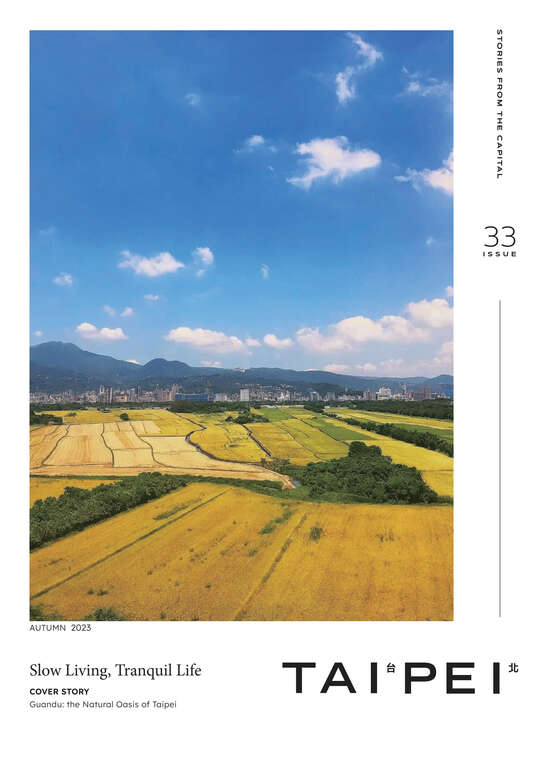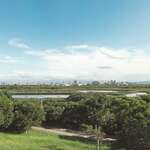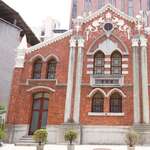Post date:2023-09-11
542
TAIPEI #33 (2023 Autumn)
The Beauty of Sacred Spaces — A Taipei Church Tour
Author Jenna Lynn Cody
Photographer Chè-lâm Church, Dadaocheng Church, Department of Information and Tourism, Taipei City Government, Kerstin Hsu, Louis Zhang
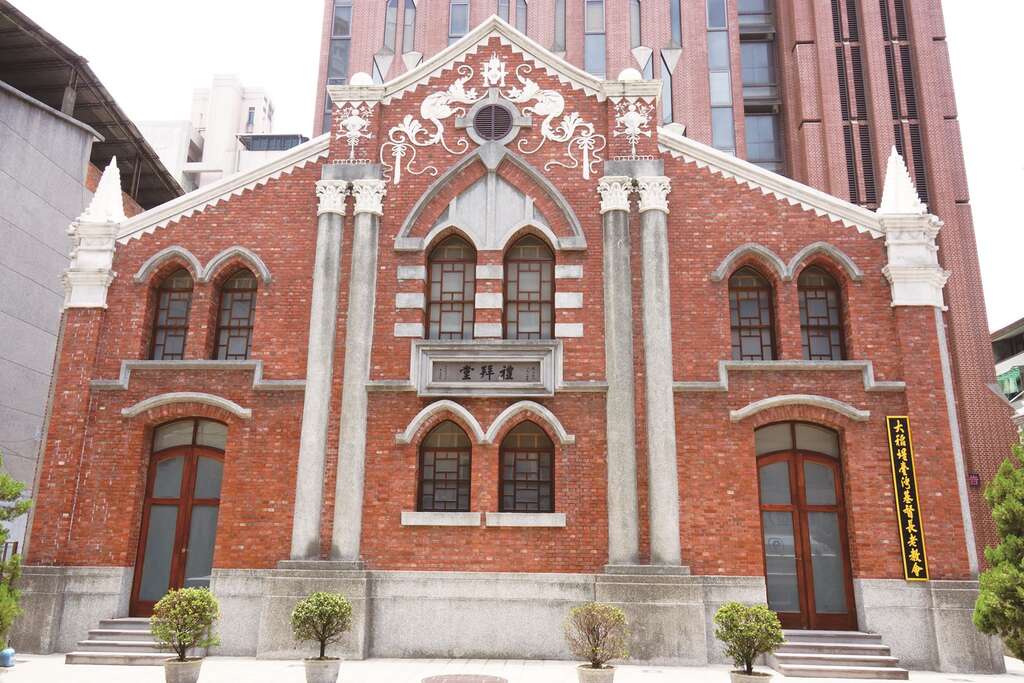 ▲The facade of Dadaocheng Church presents a wonderfully decorative face to the city street. (Photo・Department of Information and Tourism, Taipei City Government)
▲The facade of Dadaocheng Church presents a wonderfully decorative face to the city street. (Photo・Department of Information and Tourism, Taipei City Government)
When most people think of spiritual architecture in Taipei, their minds go first to the temples. While it’s undeniable that Taipei’s historic temples are integral to its urban identity, the city also boasts a number of beautiful churches that have garnered the interest of architects, architecture enthusiasts and urban explorers alike. Scattered across Taipei, these churches are testament to the city’s religious and cultural diversity, as well as its multifaceted history.
Some architectural gems also have a colorful story to tell, such as the Dadaocheng Presbyterian Church (台湾基督長老教會大稻埕教會), founded by Dr. Leslie Mackay in the 19th century, but relocated and rebuilt since then. Others are even older, such as the 18th-century Chè-lâm Presbyterian Church (台湾基督長老教會濟南教會), or named for well-known figures, such as the Lee Chun-Sheng Memorial Christ Presbyterian Church (李春生紀念基督長老教會). Unlike its red-brick counterparts, the Chungshan Presbyterian Church (台灣基督長老教會台北中山教會) has a distinctive black-and-white edifice that draws visitors from across Taipei, serving as a local landmark.
Whichever church you choose to visit, these architectural gems reveal some of Taipei’s quieter history to those who take the time to look.
Dadaocheng Presbyterian Church
Few foreigners who have built lives in Taiwan have had as much impact on its history as Dr. George Leslie Mackay, founder of the Dadaocheng Presbyterian Church. Mackay arrived in Taiwan as a missionary in 1872, offering a mobile dentistry services before founding both churches and hospitals. The Dadaocheng Church was first built in 1875 on what is now Section 3, Yanping North Road (延平北路三段). It was destroyed in the Sino-French War in 1884, moving temporarily to what is now Dihua Street (迪化街). In the early 20th century, Lee Chun-Sheng (李春生), the “father of Taiwan tea,” donated the land along what is now Ganzhou Street (甘州街), where the church stands today.
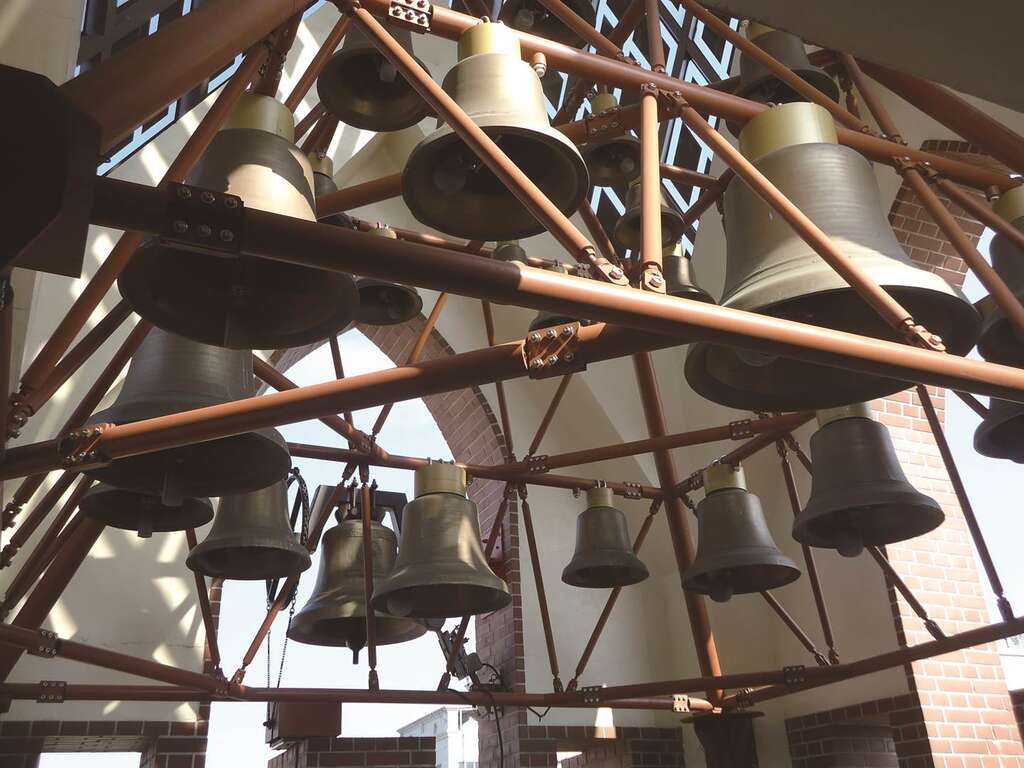 ▲The bells of Dadaocheng Church can play many different songs. (Photo・Dadaocheng Church)
▲The bells of Dadaocheng Church can play many different songs. (Photo・Dadaocheng Church)
The current building was completed in 1915, making it the oldest church in Taipei by construction date. In fact, it is one of the four remaining Presbyterian church buildings constructed during the Japanese era in Greater Taipei. The other three are the Chè-lâm, Chungshan and Tamsui (淡水) churches.
Walking down quiet, leafy Ganzhou Street, one might not expect to come upon this unassuming red-brick church. A modern church building towers over the original 1915 chapel, but it is the older edifice that draws those interested in historical architecture. The facade echoes the traditional look of old Taiwanese mansions, strongly influenced by the architectural trends of the Japanese era. The overall style balances simplicity and fine craftsmanship with the decorative elements of Japanese-influenced Gothic architecture, most notably the organic lines of the ornamental clay work around the oeil-de-boeuf (ox-eye window) in the center gable, a clear nod to Art Nouveau design. Other elements, such as the gothic pointed arches with hood molds, clerestory windows and imitation Corinthian columns are all clear indications of church architecture.
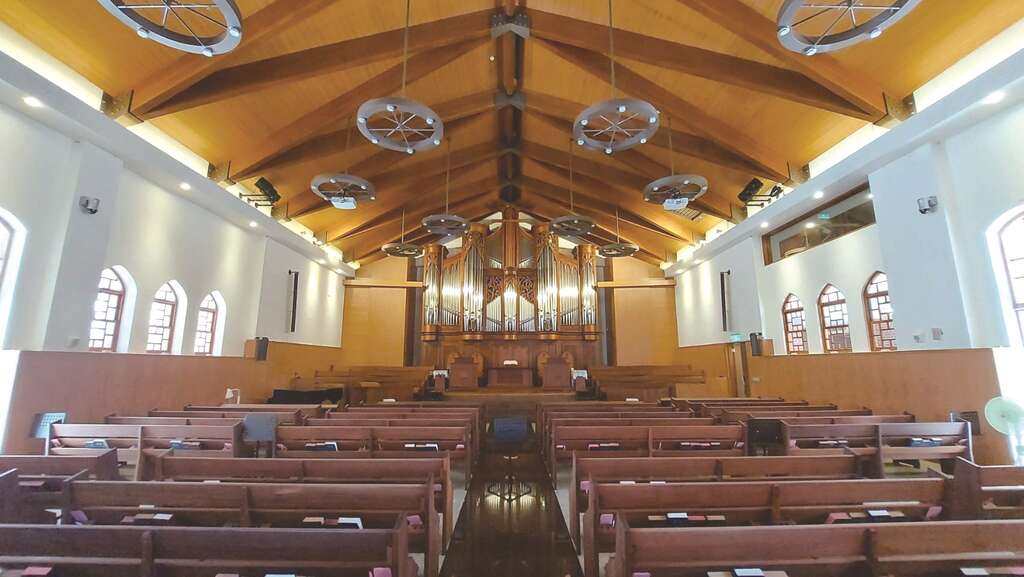 ▲Dadaocheng Church is one of the oldest churches from the Japanese era. (Photo・Dadaocheng Church)
▲Dadaocheng Church is one of the oldest churches from the Japanese era. (Photo・Dadaocheng Church)
Keen observers will notice that the church has two entrances on each side of the main gable, rather than one central entrance. This is because, in the past, the church segregated seating by gender; men and women were required to use separate entrances as well. The church also has a unique musical bell clock that rotates between seven different songs on its 25 bells to mark the noontime hour.
Chè-lâm Presbyterian Church
A visitor to Taipei would likely not expect an 18th-century style church tucked into a corner next to the Legislative Yuan, in a neighborhood known for government offices. Its neighbors are the Ministry of Education and the Control Yuan. But this is Taipei, where gems can be found in unexpected places! The edifice is rendered in locally-produced red brick made by Taiwan Renga, a brick manufacturing company during the Japanese era, intricately layered with white stone quarried in northern Taiwan.
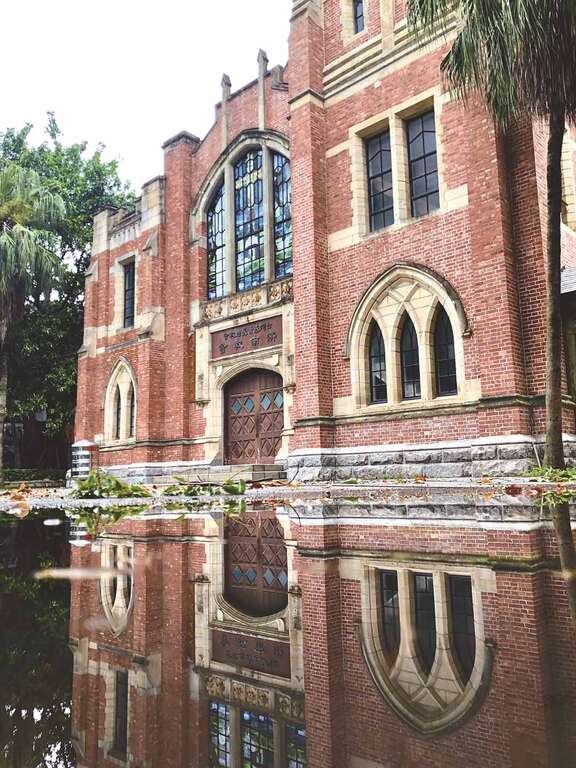 ▲Chè-lâm Church was built with red bricks produced during the Japanese era and white stones quarried in Taiwan. (Photo‧Chè-lâm Church)
▲Chè-lâm Church was built with red bricks produced during the Japanese era and white stones quarried in Taiwan. (Photo‧Chè-lâm Church)
The fundamental design is that of an 18th-century Neo-Gothic church; it would not be out of place in a rural English town, and was indeed intended to imitate that style. The front edifice is composed of recessed Tudor-style gables with a large clerestory window, which had been fitted with clear glass in 1985 before being reverted to its original stained-glass glory. Buttresses and Gothic pointed arches abound, as well as square windows ringed with staggered masonry. The shutters on the bell tower are actually stone, built for durability, light reduction and ventilation. It is the only church roof in Taiwan to be composed of distinctive fish-scale shingles, which are no longer produced in Taiwan.
The Chè-lâm Prebyterian Church, its colloquial name taken from the intersection where it is located, has not only weathered storms, earthquakes and armed conflicts, but has also borne witness to a critical period not just in Taipei’s history, but in Taiwan’s as a whole. While Western Missionaries such as James Laidlaw Maxwell and Dr. George Leslie Mackay made the church an institution, Japanese Presbyterians also played a role in the establishment of the congregation. Before the construction of the Chè-lâm Church, this smaller group met on what is now called Hankou Street (漢口街), near the Red House (紅樓) in Ximending.
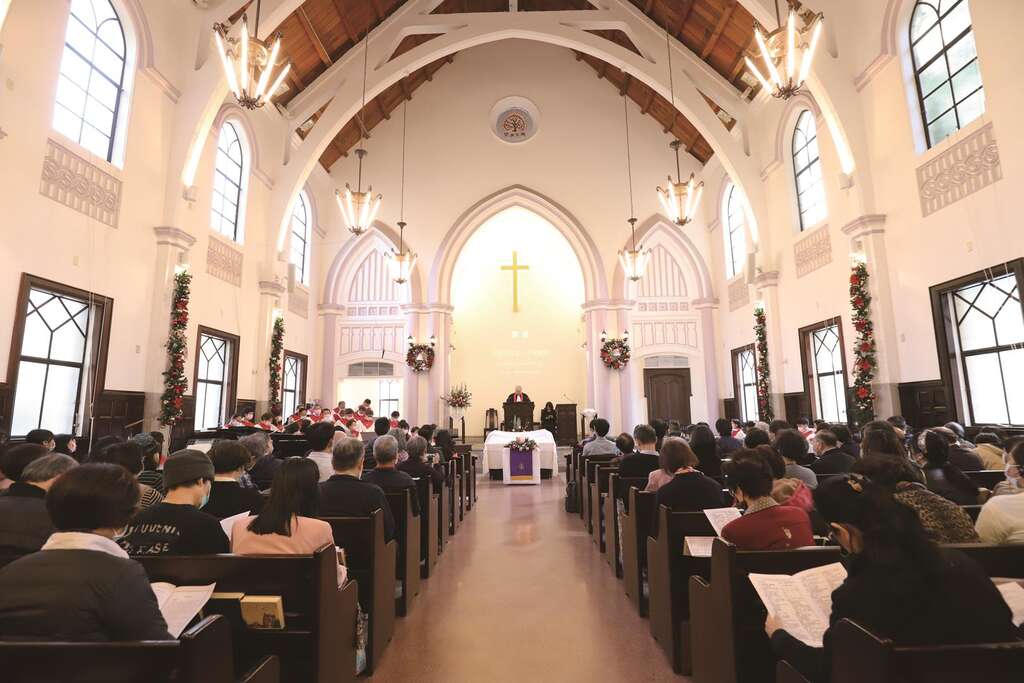 ▲The interior of Chè-lâm Church is very austere and grand. (Photo‧Chè-lâm Church)
▲The interior of Chè-lâm Church is very austere and grand. (Photo‧Chè-lâm Church)
Built in 1916, the Chè-lâm Church was designed by Ide Kaoru (井手薰) , an architect whose other accomplishments include Zhongshan Hall (中山堂) in Ximen, the Judicial Yuan, designed in the Imperial Crown style, and the nearby Executive Yuan, in a more modern Art Deco style. Ide also sought the guidance of Japanese designer Moriyama Matsunosuke (森山松之助) , who was involved in designing the Presidential Office Building and the Tobacco and Liquor Monopoly Bureau, all considered important historical buildings in Taipei.
Lee Chun-Sheng Memorial Christ Presbyterian Church
Anyone who has not just a memorial, but a memorial church named for them, must have been quite a towering historical figure. The Lee Chun-Sheng Memorial Christ Presbyterian Church, dedicated by the eponymous Lee Chun-Sheng’s grandchildren and other descendants, is a small, unassuming red-brick building. One of the more interesting qualities of the church is the front façade, which resembles a face — the main doorway suggesting a mouth and the two upper windows resembling eyes. It sits on quiet, narrow Guide Street (貴德街) in the westernmost slice of the Dadaocheng neighborhood.
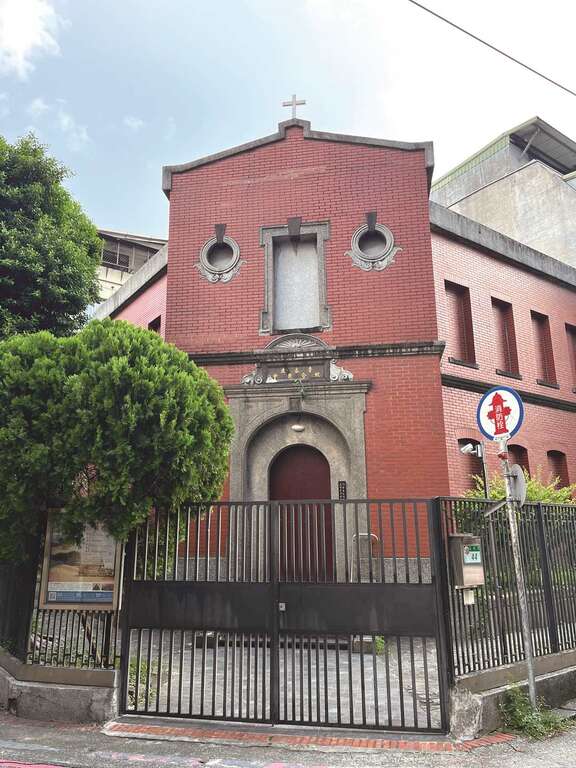 ▲Lee Chun-Sheng Memorial Church features red brick architecture and western decorative elements. (Photo・Kerstin Hsu)
▲Lee Chun-Sheng Memorial Church features red brick architecture and western decorative elements. (Photo・Kerstin Hsu)
Lee Chun-Sheng indeed played an important role in Taiwanese history, known today as the “Father of Taiwan Tea.” Lee was born the son of a poor boatman in Xiamen, Fujian, China. He worked for Chinese tea companies before being recruited for his managerial talent by John Dodd, turning tea into Taiwan’s most valuable export.
Lee was also a committed Christian, donating both capital and land for the construction of multiple Presbyterian churches across Taipei. The Lee Chun-Sheng Memorial Church was constructed in 1935, and originally functioned as the Dadaocheng Post and Telegraph Office — the first post office in Taiwan. The building itself is still in use today: a modest two-story chapel that takes its cues from Japanese-era Neo-Baroque style and other Western influences, such as the double-arched doorway with a keystone lintel, molded decorative elements and oeil-de-boeuf windows. Also notable is the Chinese-style plaque above the door bearing the name of the church.
Chungshan Presbyterian Church
Red-brick chapels on quiet streets might seem to be the standard for Taipei’s churches, but the Chungshan Presbyterian Church’s distinctiveness lies in the bucking of these expectations. Situated on the busy intersection of Linsen North Road (林森北路) and Changan East Road (長安東路), the Chungshan Church is a popular site for wedding photography due to its striking Neo-Gothic facade, which in a certain light may appear black and white.
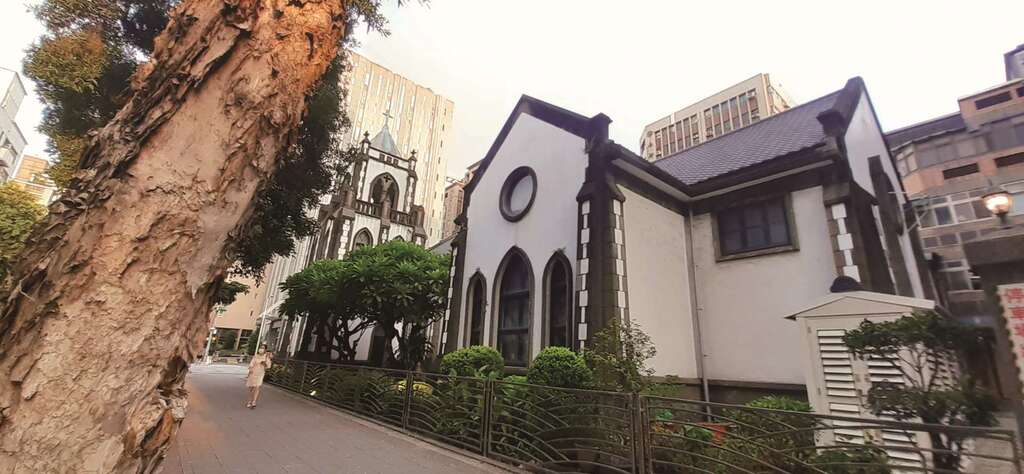 ▲The black and white architectural appearance of Chungshan Church is very different from other churches in Taipei. (Photo・Louis Zhang)
▲The black and white architectural appearance of Chungshan Church is very different from other churches in Taipei. (Photo・Louis Zhang)
Constructed in 1937 under Japanese pastor Ohashi Rintaro (大橋麟太郎), the Chungshan Church began its life not as a Presbyterian house of worship, but an Anglican one. When the Japanese left Taiwan, however, there was no local Anglican diocese at the time, and thus it was agreed that it would be taken over by the Presbyterian mission instead.
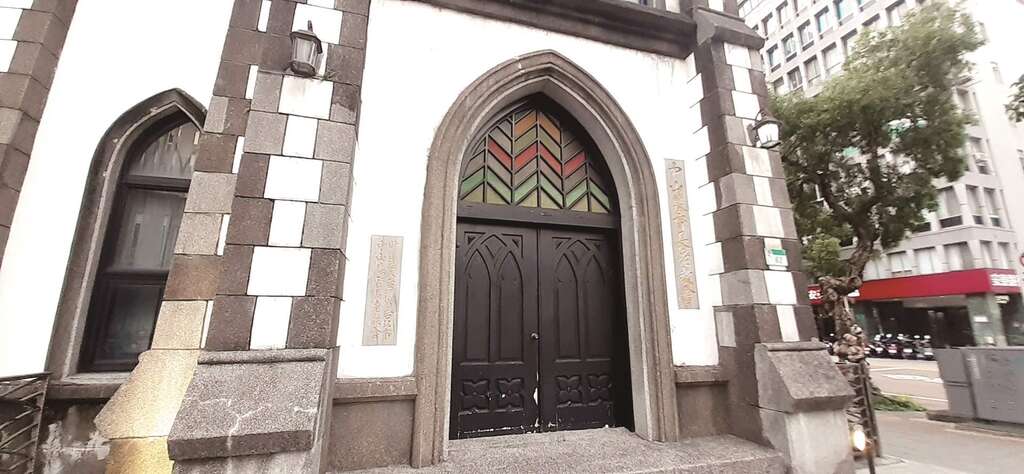 ▲Chungshan Church imitates the English architectural style. (Photo・Louis Zhang)
▲Chungshan Church imitates the English architectural style. (Photo・Louis Zhang)
The exterior design imitates a church in England, but in a very different sense than the aforementioned Chè-lâm Church. The high-contrast edifice is made of white stone paired with dark pebbledash, which adorns the staggered masonry along the buttresses. Inside, milk glass pendants hang from a hammer beam roof, giving the space a sense of elegant timelessness.
When viewed from above, the roof forms a cross, with a bell tower at one end. At either end are oeil-de-boeuf windows, each with a stained glass rendering of Jesus: in one he prays at the Garden of Gethsemane, and in the other he acts as a shepherd, a common Christian symbol. Stained glass chevrons above the old wooden door and Gothic pointed arch windows add to the splendor of this small church.
Besides Mandarin and Taiwanese service, Presbyterian churches in Taipei are known to provide services in other languages such as English, Japanese and Hakka. In addition, visitors are reminded to ask permission before taking pictures. Visits outside of regular service hours are possible, but it is advised to call in advance if you wish to enter the buildings.
The Beauty of Sacred Spaces — A Taipei Church Tour
Author Jenna Lynn Cody
Photographer Chè-lâm Church, Dadaocheng Church, Department of Information and Tourism, Taipei City Government, Kerstin Hsu, Louis Zhang
 ▲The facade of Dadaocheng Church presents a wonderfully decorative face to the city street. (Photo・Department of Information and Tourism, Taipei City Government)
▲The facade of Dadaocheng Church presents a wonderfully decorative face to the city street. (Photo・Department of Information and Tourism, Taipei City Government)When most people think of spiritual architecture in Taipei, their minds go first to the temples. While it’s undeniable that Taipei’s historic temples are integral to its urban identity, the city also boasts a number of beautiful churches that have garnered the interest of architects, architecture enthusiasts and urban explorers alike. Scattered across Taipei, these churches are testament to the city’s religious and cultural diversity, as well as its multifaceted history.
Some architectural gems also have a colorful story to tell, such as the Dadaocheng Presbyterian Church (台湾基督長老教會大稻埕教會), founded by Dr. Leslie Mackay in the 19th century, but relocated and rebuilt since then. Others are even older, such as the 18th-century Chè-lâm Presbyterian Church (台湾基督長老教會濟南教會), or named for well-known figures, such as the Lee Chun-Sheng Memorial Christ Presbyterian Church (李春生紀念基督長老教會). Unlike its red-brick counterparts, the Chungshan Presbyterian Church (台灣基督長老教會台北中山教會) has a distinctive black-and-white edifice that draws visitors from across Taipei, serving as a local landmark.
Whichever church you choose to visit, these architectural gems reveal some of Taipei’s quieter history to those who take the time to look.
Dadaocheng Presbyterian Church
Few foreigners who have built lives in Taiwan have had as much impact on its history as Dr. George Leslie Mackay, founder of the Dadaocheng Presbyterian Church. Mackay arrived in Taiwan as a missionary in 1872, offering a mobile dentistry services before founding both churches and hospitals. The Dadaocheng Church was first built in 1875 on what is now Section 3, Yanping North Road (延平北路三段). It was destroyed in the Sino-French War in 1884, moving temporarily to what is now Dihua Street (迪化街). In the early 20th century, Lee Chun-Sheng (李春生), the “father of Taiwan tea,” donated the land along what is now Ganzhou Street (甘州街), where the church stands today.
 ▲The bells of Dadaocheng Church can play many different songs. (Photo・Dadaocheng Church)
▲The bells of Dadaocheng Church can play many different songs. (Photo・Dadaocheng Church)The current building was completed in 1915, making it the oldest church in Taipei by construction date. In fact, it is one of the four remaining Presbyterian church buildings constructed during the Japanese era in Greater Taipei. The other three are the Chè-lâm, Chungshan and Tamsui (淡水) churches.
Walking down quiet, leafy Ganzhou Street, one might not expect to come upon this unassuming red-brick church. A modern church building towers over the original 1915 chapel, but it is the older edifice that draws those interested in historical architecture. The facade echoes the traditional look of old Taiwanese mansions, strongly influenced by the architectural trends of the Japanese era. The overall style balances simplicity and fine craftsmanship with the decorative elements of Japanese-influenced Gothic architecture, most notably the organic lines of the ornamental clay work around the oeil-de-boeuf (ox-eye window) in the center gable, a clear nod to Art Nouveau design. Other elements, such as the gothic pointed arches with hood molds, clerestory windows and imitation Corinthian columns are all clear indications of church architecture.
 ▲Dadaocheng Church is one of the oldest churches from the Japanese era. (Photo・Dadaocheng Church)
▲Dadaocheng Church is one of the oldest churches from the Japanese era. (Photo・Dadaocheng Church)Keen observers will notice that the church has two entrances on each side of the main gable, rather than one central entrance. This is because, in the past, the church segregated seating by gender; men and women were required to use separate entrances as well. The church also has a unique musical bell clock that rotates between seven different songs on its 25 bells to mark the noontime hour.
Chè-lâm Presbyterian Church
A visitor to Taipei would likely not expect an 18th-century style church tucked into a corner next to the Legislative Yuan, in a neighborhood known for government offices. Its neighbors are the Ministry of Education and the Control Yuan. But this is Taipei, where gems can be found in unexpected places! The edifice is rendered in locally-produced red brick made by Taiwan Renga, a brick manufacturing company during the Japanese era, intricately layered with white stone quarried in northern Taiwan.
 ▲Chè-lâm Church was built with red bricks produced during the Japanese era and white stones quarried in Taiwan. (Photo‧Chè-lâm Church)
▲Chè-lâm Church was built with red bricks produced during the Japanese era and white stones quarried in Taiwan. (Photo‧Chè-lâm Church)The fundamental design is that of an 18th-century Neo-Gothic church; it would not be out of place in a rural English town, and was indeed intended to imitate that style. The front edifice is composed of recessed Tudor-style gables with a large clerestory window, which had been fitted with clear glass in 1985 before being reverted to its original stained-glass glory. Buttresses and Gothic pointed arches abound, as well as square windows ringed with staggered masonry. The shutters on the bell tower are actually stone, built for durability, light reduction and ventilation. It is the only church roof in Taiwan to be composed of distinctive fish-scale shingles, which are no longer produced in Taiwan.
The Chè-lâm Prebyterian Church, its colloquial name taken from the intersection where it is located, has not only weathered storms, earthquakes and armed conflicts, but has also borne witness to a critical period not just in Taipei’s history, but in Taiwan’s as a whole. While Western Missionaries such as James Laidlaw Maxwell and Dr. George Leslie Mackay made the church an institution, Japanese Presbyterians also played a role in the establishment of the congregation. Before the construction of the Chè-lâm Church, this smaller group met on what is now called Hankou Street (漢口街), near the Red House (紅樓) in Ximending.
 ▲The interior of Chè-lâm Church is very austere and grand. (Photo‧Chè-lâm Church)
▲The interior of Chè-lâm Church is very austere and grand. (Photo‧Chè-lâm Church)Built in 1916, the Chè-lâm Church was designed by Ide Kaoru (井手薰) , an architect whose other accomplishments include Zhongshan Hall (中山堂) in Ximen, the Judicial Yuan, designed in the Imperial Crown style, and the nearby Executive Yuan, in a more modern Art Deco style. Ide also sought the guidance of Japanese designer Moriyama Matsunosuke (森山松之助) , who was involved in designing the Presidential Office Building and the Tobacco and Liquor Monopoly Bureau, all considered important historical buildings in Taipei.
Lee Chun-Sheng Memorial Christ Presbyterian Church
Anyone who has not just a memorial, but a memorial church named for them, must have been quite a towering historical figure. The Lee Chun-Sheng Memorial Christ Presbyterian Church, dedicated by the eponymous Lee Chun-Sheng’s grandchildren and other descendants, is a small, unassuming red-brick building. One of the more interesting qualities of the church is the front façade, which resembles a face — the main doorway suggesting a mouth and the two upper windows resembling eyes. It sits on quiet, narrow Guide Street (貴德街) in the westernmost slice of the Dadaocheng neighborhood.
 ▲Lee Chun-Sheng Memorial Church features red brick architecture and western decorative elements. (Photo・Kerstin Hsu)
▲Lee Chun-Sheng Memorial Church features red brick architecture and western decorative elements. (Photo・Kerstin Hsu)Lee Chun-Sheng indeed played an important role in Taiwanese history, known today as the “Father of Taiwan Tea.” Lee was born the son of a poor boatman in Xiamen, Fujian, China. He worked for Chinese tea companies before being recruited for his managerial talent by John Dodd, turning tea into Taiwan’s most valuable export.
Lee was also a committed Christian, donating both capital and land for the construction of multiple Presbyterian churches across Taipei. The Lee Chun-Sheng Memorial Church was constructed in 1935, and originally functioned as the Dadaocheng Post and Telegraph Office — the first post office in Taiwan. The building itself is still in use today: a modest two-story chapel that takes its cues from Japanese-era Neo-Baroque style and other Western influences, such as the double-arched doorway with a keystone lintel, molded decorative elements and oeil-de-boeuf windows. Also notable is the Chinese-style plaque above the door bearing the name of the church.
Chungshan Presbyterian Church
Red-brick chapels on quiet streets might seem to be the standard for Taipei’s churches, but the Chungshan Presbyterian Church’s distinctiveness lies in the bucking of these expectations. Situated on the busy intersection of Linsen North Road (林森北路) and Changan East Road (長安東路), the Chungshan Church is a popular site for wedding photography due to its striking Neo-Gothic facade, which in a certain light may appear black and white.
 ▲The black and white architectural appearance of Chungshan Church is very different from other churches in Taipei. (Photo・Louis Zhang)
▲The black and white architectural appearance of Chungshan Church is very different from other churches in Taipei. (Photo・Louis Zhang)Constructed in 1937 under Japanese pastor Ohashi Rintaro (大橋麟太郎), the Chungshan Church began its life not as a Presbyterian house of worship, but an Anglican one. When the Japanese left Taiwan, however, there was no local Anglican diocese at the time, and thus it was agreed that it would be taken over by the Presbyterian mission instead.
 ▲Chungshan Church imitates the English architectural style. (Photo・Louis Zhang)
▲Chungshan Church imitates the English architectural style. (Photo・Louis Zhang)The exterior design imitates a church in England, but in a very different sense than the aforementioned Chè-lâm Church. The high-contrast edifice is made of white stone paired with dark pebbledash, which adorns the staggered masonry along the buttresses. Inside, milk glass pendants hang from a hammer beam roof, giving the space a sense of elegant timelessness.
When viewed from above, the roof forms a cross, with a bell tower at one end. At either end are oeil-de-boeuf windows, each with a stained glass rendering of Jesus: in one he prays at the Garden of Gethsemane, and in the other he acts as a shepherd, a common Christian symbol. Stained glass chevrons above the old wooden door and Gothic pointed arch windows add to the splendor of this small church.
Besides Mandarin and Taiwanese service, Presbyterian churches in Taipei are known to provide services in other languages such as English, Japanese and Hakka. In addition, visitors are reminded to ask permission before taking pictures. Visits outside of regular service hours are possible, but it is advised to call in advance if you wish to enter the buildings.
2023 Taipei Christmas — Infinite Love When discussing churches in Taipei, one cannot overlook the significance of “Taipei Christmas — Infinite Love” as a prominent event. Christmas is a special time for the city, and each year, Taipei City Government collaborates with religious groups and others to organize the Taipei Christmas event series. 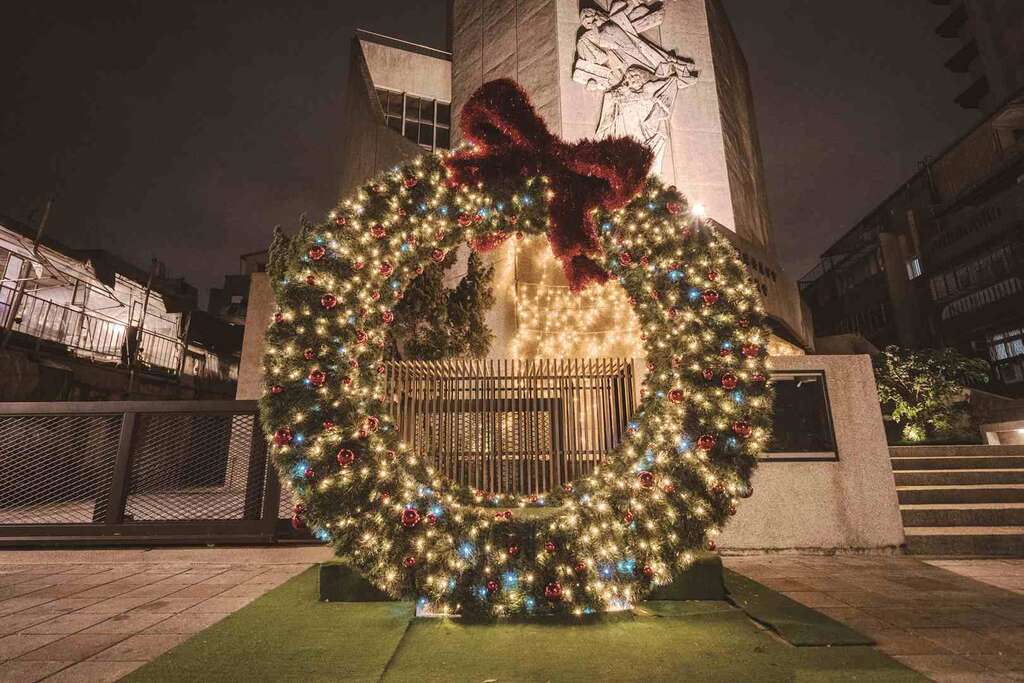 This year marks the third year of the collaboration, featuring a range of activities from Christmas tree lighting and caroling to shopping district promotions and raffles. The event is scheduled to run from early December 2023 to early March 2024, covering the Gongguan Shopping District, Yongkang Shopping District, Exit 11 of Daan Park, and the vicinity of Section 1 to Section 3 of Xinsheng South Road. It will showcase dazzling, Insta-worthy light displays and enticing promotion events. As the year draws to a close, the event invites everyone to experience the heartwarming Christmas atmosphere in Taipei. This year marks the third year of the collaboration, featuring a range of activities from Christmas tree lighting and caroling to shopping district promotions and raffles. The event is scheduled to run from early December 2023 to early March 2024, covering the Gongguan Shopping District, Yongkang Shopping District, Exit 11 of Daan Park, and the vicinity of Section 1 to Section 3 of Xinsheng South Road. It will showcase dazzling, Insta-worthy light displays and enticing promotion events. As the year draws to a close, the event invites everyone to experience the heartwarming Christmas atmosphere in Taipei.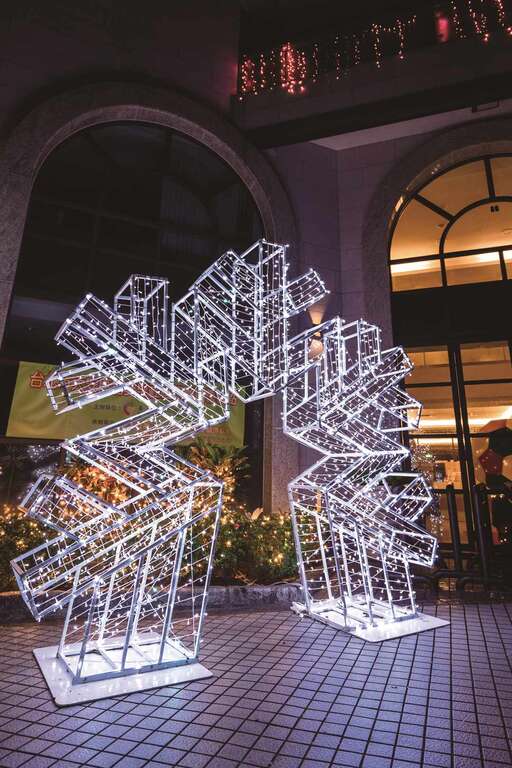 |
Gallery
:::
Popular articles
 Guandu: the Natural Oasis of Taipei (TAIPEI Quarterly 2023 Autumn Vol.33)
Guandu: the Natural Oasis of Taipei (TAIPEI Quarterly 2023 Autumn Vol.33) TAIPEI Quarterly 2023 Autumn Vol.33
TAIPEI Quarterly 2023 Autumn Vol.33 Eastern District + Xinyi District Taipei's East, Internationalized Gallery of Architectural Masterworks (TAIPEI Quarterly 2023 Autumn Vol.33)
Eastern District + Xinyi District Taipei's East, Internationalized Gallery of Architectural Masterworks (TAIPEI Quarterly 2023 Autumn Vol.33) Guting: Leisure in Southern Taipei (TAIPEI Quarterly 2023 Autumn Vol.33)
Guting: Leisure in Southern Taipei (TAIPEI Quarterly 2023 Autumn Vol.33) The Beauty of Sacred Spaces ― A Taipei Church Tour (TAIPEI Quarterly 2023 Autumn Vol.33)
The Beauty of Sacred Spaces ― A Taipei Church Tour (TAIPEI Quarterly 2023 Autumn Vol.33) Tracing Taipei's Calligraphy Then and Now: Chu Chen-Nan's Artistic Journey and Insights (TAIPEI Quarterly 2023 Autumn Vol.33)
Tracing Taipei's Calligraphy Then and Now: Chu Chen-Nan's Artistic Journey and Insights (TAIPEI Quarterly 2023 Autumn Vol.33)
 The Beauty of Sacred Spaces ― A Taipei Church Tour (TAIPEI Quarterly 2023 Autumn Vol.33)
The Beauty of Sacred Spaces ― A Taipei Church Tour (TAIPEI Quarterly 2023 Autumn Vol.33)